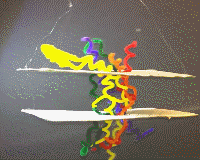Tutorial:The opioid receptor, a molecular switch
From Proteopedia
| Line 13: | Line 13: | ||
== Structural highlights == | == Structural highlights == | ||
| - | <StructureSection load='' size='340' side='right' caption='' scene='83/830406/Gpcr/ | + | <StructureSection load='' size='340' side='right' caption='' scene='83/830406/Gpcr/2'> |
You can check out the <scene name='83/830406/Gpcr/1'>structure</scene> in the window on the right. Try rotating the molecule after turning off the automatic spinning (+/- spin button). | You can check out the <scene name='83/830406/Gpcr/1'>structure</scene> in the window on the right. Try rotating the molecule after turning off the automatic spinning (+/- spin button). | ||
Revision as of 13:22, 5 December 2019
The opioid receptor, a protein on the surface of nerve cells, binds to opioids such as morphine, oxicodone, heroin, and fentanyl. Repeated intake of opioids changes the response to these molecules, and can lead to addiction. This article explains, at a level appropriate to high school students or beginning college students, how the opioid receptor is switched on and off, and what happens inside the brain as a consequence.
Contents |
Relevance
When we want to turn on the lights in a dark room, we don't have to climb up a ladder to screw in a light bulb. All we have to do is flip a switch. A biological cell has switches, too, called receptors. Most are on the cell surface with a part sticking out, ready to bind to a signaling molecule. Another part of the receptor reaches into the inside of the cell, transmitting the signal. The opioid receptor can be switched on to relieve pain, for example during surgery. Tragically, it is very easy to become physically dependent on the signaling molecules. The ongoing opioid crisis in the USA shows how addictive opioids are (e.g. morphine, oxicodone, heroin, and fentanyl), with overdose deaths decreasing average life expectancy across the US population significantly.
Natural Function
Talk about endorphins here, with link to receptor video.
Disease and treatment
Talk about pain medication, drug abuse and overdose treatment with naloxone here. Links to other four videos at appropriate sections.
Structural highlights
| |||||||||||

